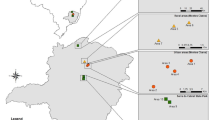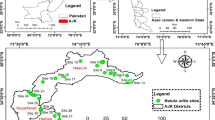Abstract
During recovery succession, structural and functional changes in oribatid mite communities occur: the number of species increases, the structure becomes more complex, the proportion of surface-living and nonspecialized forms increases, and the role of parthenogenetic species decreases. The direction of succession is to form a community characteristic of the zonal type of vegetation. Four stages are selected. The colonization-accumulation stage involves the initial accumulation of organic matter due to activity of microorganisms. Oribatids are not numerous at this stage. The unstructured stage is characterized by unstable monodominant communities of parthenogenetic oribatids with short life cycles. The next stage is structuring, when the proportion of parthenogenetic forms decreases, and that of nonspecialized forms increases. Communities are monodominant. The final stage is stabilization. The proportion of parthenogenetic species decreases noticeably. The generic and species composition of the communities stabilizes. The community achieves zonal features.
Similar content being viewed by others
References
Artem’eva, T.I., Kompleksy pochvennykh zhivotnykh i voprosy rekul’tivatsii tekhnogennykh territorii (Complexes of Soil Animals and Problems of Recultivation of Technogenically Modified Areas), Moscow: Nauka, 1989.
Artem’eva, T.I., Soil Animals as Indicators of Biological Recultivation of Technogenically Modified Areas, in Tr. 9-go mezhdunar. kollokviuma po pochvennoi zoologii “Pochvennaya fauna i pochvennoe plodorodie” (Proc. 9th Int. Colloq. Soil Zoology “Soil Fauna and Soil Fertility), Moscow: Nauka, 1987, pp. 229–233.
Chernov, Yu.I., The Main Synecological Characteristics of Soil Invertebrates and Methods of Their Analysis, in Metody pochvenno-zoologicheskikh issledovanii (Methods of Soil-Zoological Studies), Moscow: Nauka, 1975, pp. 160–216.
Chistyakov, M.P., Horizontal Distribution of Oribatei on Depleted Peat Soils of Balakhninskaya Depression, Ekologiya, 1974, no. 3, pp. 53–58.
Chistyakov, M.P., Seasonal Dynamics of Abundance of Oribatid Mites on Depleted Peat Soils of Gorky Oblast, Ekologiya, 1971, no. 6, pp. 78–83.
Gregori, F., Mikroflora vozdukha (Air Microflora), Moscow: Mir, 1964.
Kondrat’eva, L.M., Morskie bakterii i pervichnoe pochvoobrazovanie na vulkanoklastakh. Vladivostok; (Marine Bacteria and Primary Soil Formation on Volcanoclastic Sediments), Vladivostok: Dal’nauka, 1996.
Krivolutskii, D.A., Method of Complex Examination of Soils for Population with Microarthropods, in Metody pochvennozoologicheskikh issledovanii (Methods of Soil-Zoological Studies), Moscow: Nauka, 1975, pp. 44–48.
Krupskaya, L.T., Okhrana i ratsional’noe ispol’zovanie zemel’ na gornykh predpriyatiyakh Priamur’ya i Primor’ya (Conservation and Sustainable Use of Lands at Mining Plants in Primorie and Amur River Region), Khabarovsk: Izd. Priamursk. Geografich. Obshch., 1992.
Kuzyakina, T.I., Transformation of Volcanic Ash by Microorganisms, in Vulkanizm i svyazannye s nim protsessy. Vyp. 3 (Volcanism and Related Processes), issue 3, Petropavlovsk-Kamchatskii: Dal’nauka, 1985, pp. 232–234.
Markhinin, E.K., Vulkany i zhizn’ (Volcanoes and Life), Moscow: Mysl’, 1980.
Maynard, S.J., The Evolution of Sex, Cambridge: Cambridge Univ. Press, 1978. Translated under the title Evolyutsiya polovogo razmnozheniya, Moscow: Mir, 1981.
Pimenov, E.P., Function of Microorganism Complexes of in the Intensive Volcanic Ashfall Zone, Extended Abstract of Cand. Sci. (Biol.) Dissertation, Alma-Ata: Inst. Mikrobiol. Virusol. Akad. Nauk KazSSR, 1983.
Ryabinin, N.A. and Pan’kov, A.N., Role of Parthenogenesis in the Biology of Mites, Ekologiya, 1987, no. 4, pp. 62–64.
Schwabe, C., Zur Okogenese auf Surtsey, Schr. Naturwiss. Verl. Schleswig-Halstein. Sonderbd., 1970, pp. 101–120.
Ten Khak Mun and Kuzyakina, T.I., Proportion of Volcanic Substances of Microflora in Volcanic Ashes, Dokl. Akad. Nauk SSSR, 1976, vol. 231, no. 1, pp. 232–235.
Ten Khak Mun and Rogova, O.A., Microbial Colonization of Volcanic Ashes, Izv. Akad. Nauk SSSR, Ser. Biol., 1980, vol. 2, pp. 261–266.
Author information
Authors and Affiliations
Corresponding author
Additional information
Original Russian Text © N.A. Ryabinin, A.N. Pan’kov, 2009, published in Izvestiya Akademii Nauk, Seriya Biologicheskaya, 2009, No. 5, pp. 604–609.
Rights and permissions
About this article
Cite this article
Ryabinin, N.A., Pan’kov, A.N. Successions of oribatid mites (Acariformes: Oribatida) on disturbed areas. Biol Bull Russ Acad Sci 36, 510–515 (2009). https://doi.org/10.1134/S1062359009050136
Received:
Published:
Issue Date:
DOI: https://doi.org/10.1134/S1062359009050136




